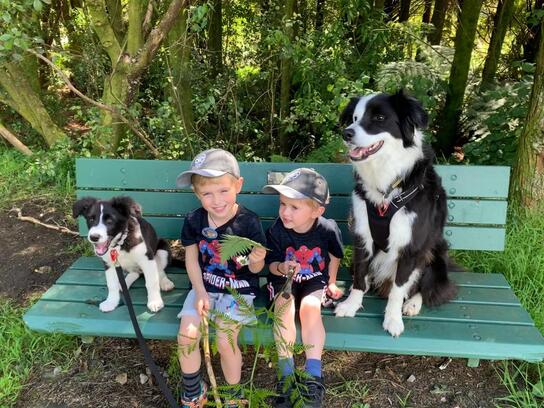|
Many of you will have spoken or corresponded with our Superhuman General Assistant, Letisha, even if you haven’t met her in person. She is the first port of call for enquiries, manages bookings, keeps everyone on track, and so much more. By proxy, we are also incredibly lucky to be able to work with her amazing sons, Logan and Archie. They have helped so many puppies in what are their first interactions with small children.
Logan and Archie are 7 and 6, and help teach other kids the right way to act around young dogs as well as being some puppy's first experience with smaller humans. We almost can’t bear to watch them grow up as they have been so integral to our courses and have so much fun with our puppy classes. Recently Letisha and the boys have helped multiple classes graduate, and from Letisha's experience, she has compiled some top tips for making sure interactions and play goes as smoothly as possible and is a positive experience for all! Always supervise! No matter how well behaved you think your kids or your puppy are, think again! It takes just a moment for an unpleasurable incident for either to occur. It makes your job harder to then have to undo any negative experiences either party have, than it would have been to have set up the interaction properly in the first place. No chasing! That means the children don’t chase the puppy around and you don’t let the puppy chase the kids around. As fun as this looks & sounds sometimes, it never ends well and can instil some instinctive behaviours or over arousal behaviours (like nipping, grabbing or mounting) in your puppy you may not want as they grow in size! If you or your kids chase your puppy to grab something from them, the puppy gets manhandled or told off while you grab from it what it has, the trust your pup just had in you is gone and it can be hard to get back. Recall is generally affected as well as making them apprehensive about handling. Crates are their safe haven! If you cannot actively supervise your children and/or puppy, put them (the puppy) away somewhere secure like a crate or a play pen. This is not a punishment and a crate should never be used as such. They are a management tool. A crate is your dog's safe place, happy place, resting place, den or retreat so to speak! Set it up like it's the best place in the world (emotionally) for them. This doesn’t mean fill it with a luxurious bed, save that for when the chewing/destruction phase has passed! What it does mean, is every opportunity you can use to show your pup a positive association to the crate, do it, so they want to go in there willingly. Position it somewhere they are still a part of the home, feed them in there, pop them in with a long lasting chew treat occasionally (even if you are just in the other room), cover it if they are a little worried or stressed. Respect their space! Teach your own children how to respect a dog’s space, especially when they are eating or sleeping. Most importantly, teach visiting children the same rules and make sure they are understood and followed. No children, no worries! If you don’t have any children in your home or only have the occasional family members visiting with children, help your pup get used to all things children related by taking them to a nearby park or playground (at a distance) and just let them observe. They can take in all the sights, sounds and smells without the need to meet them. Teach about puppy’s consent! If a child or a family approaches and asks to pat your dog, kindly ask them to keep their distance (as your puppy is just young and still learning) but to squat down and keep their hands to themselves while you approach with your puppy to see if the pup wants to meet them first. If the puppy engages and has a relaxed body you can then instruct the people to only pat on the side of the body or on the chest, just not on the head please! If the puppy chooses not to go and sniff or say hello (ignores or focuses only on you) you can say “sorry, puppy doesn’t feel like meeting people today” - reward your puppy and move off. It’s your responsibility to ensure all encounters are as positive as they can be and realise your puppy doesn't have to say hello to everyone it meets, to become a well socialised puppy. These are just the preliminary tips that we have seen that really set your puppy up for success around children (and in other areas!) Think and plan ahead, and you will set your puppy up for life. If you or anyone you know has or is getting a new puppy, our EARLY LEARNING PUPS program has courses throughout the year. Not only do we cover socialising with children, but with many other things! We can also support your puppy’s training with one on one, in-home training - so don’t be a stranger and get in touch! Authored by Letisha Anstis General Assistant Edited by Sarah Endres
0 Comments
Leave a Reply. |
AuthorsArticles created by the team at Allsorts Dog Training, Bay of Plenty, New Zealand Our Library
All
|


 RSS Feed
RSS Feed